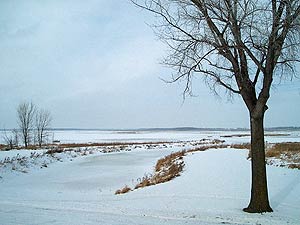|
Audio
Photos
|
 |
| Swan Lake is over 10,000 acres. It’s home to migratory birds and water fowl, including night herons and mallards. Now the DNR is drawing it down to kill invasive carp. (MPR photo/Sea Stachura) |
Nicollet, Minn. — Swan Lake spans 10,000 acres in the midst of extremely fertile farmland. On average it plumbs only three and a half feet and its channels are dotted with cattails and tiny islands. It's considered the largest prairie pothole marsh in America. And it sits in the middle of what's called "the duck factory" which spans southern Minnesota, the Dakotas, Iowa and parts of Canada.
Joel Anderson is the DNR's Area Wildlife Manager. He oversees a third of the state's wildlife lakes.
"This part is very degraded," he says, "Because originally the duck factory was all prairie and wetlands and right now the areas around here are 90 percent of our wetlands are drained."
Anderson says the region still produces thousands of mallards, night herons, and grebes. On the duck opener the lake had over a thousand hunters.
But it used to be better.
In the 1800s wagons full of ducks were slaughtered for market nightly. Kristy Zajac is the assistant area wildlife manager. She says ducks need upland cover if they are to thrive.
"Our soil is so good that most of it is used for cropland. we have a hard time getting enough upland cover and it just pretty much goes from corn to cattails to water."
With so little duck-friendly habitat, predators like foxes and skunks can easily find and kill waterfowl. So they have a hard time nesting, even with help. And when carp showed up in the lake earlier this year Anderson says that spelt trouble for the ducks.
"A big female carp might be able to lay a couple million eggs and the carp population can explode very fast," he says. "Some of these shallow lakes that do have a lot of carp in them they end up being open water areas with very little or no vegetation, they're algae dominated, the waters aren't clear."
That leaves no food for the ducks. Anderson says the DNR doesn't know how many carp are in Swan Lake, but he says on a lake this size, it's easy to spot them.
It's a mystery as to how the carp found their way into the lake. The only inlets are drainage ditches and a creek that flows south to a rocky waterfall dumping into the Minnesota River.
However they got there, getting them out requires drawing down the lake.
On a blustery winter day Anderson and Zajac lift a steel stop log from the dam at Nicollet Creek. Zajac says they've removed one girder at a time, monitoring downstream for overflow and ice breaks.
"We only pulled a few boards last week until we got most of the ice dams out of the river," she says. "Now that seems to be cleared out I think we're going to be a little more aggressive." A lake never freezes solid. Swan Lake has some deep pockets where carp will gather to survive. Anderson says he hopes that as the water levels decrease oxygen levels will decrease.
"Our goal is to take the lake down far enough so that with a combination of snow and thick ice, you'll have a very small water column under the lake," he says. "So that it's more likely to induce a winter carp kill."
Anderson says a winter kill will likely wipe out amphibians as well. And if it's a mild winter or a dry spring the draw down could result in a mostly dry lake with pockets of carp.
So far the DNR has gotten support from conservation groups like the Nicollet Conservation Club. Ryan Heinenger is the Ducks Unlimited Director for Conservation Programs. He says while the DNR is draining the lake they'll be feeding the ducks at Swan Lake and elsewhere.
"We're working in, we're calling them, stepping stones for birds as they travel on their migratory routes and by working in these wetland complexes we'll provide more diverse suite of food resources for ducks," he says
The drawdown isn't a foolproof way of getting rid of the carp. And they'll have to wait until spring to see if it's been successful. If it's not it wouldn't be the first time Swan Lake has gone dry.







